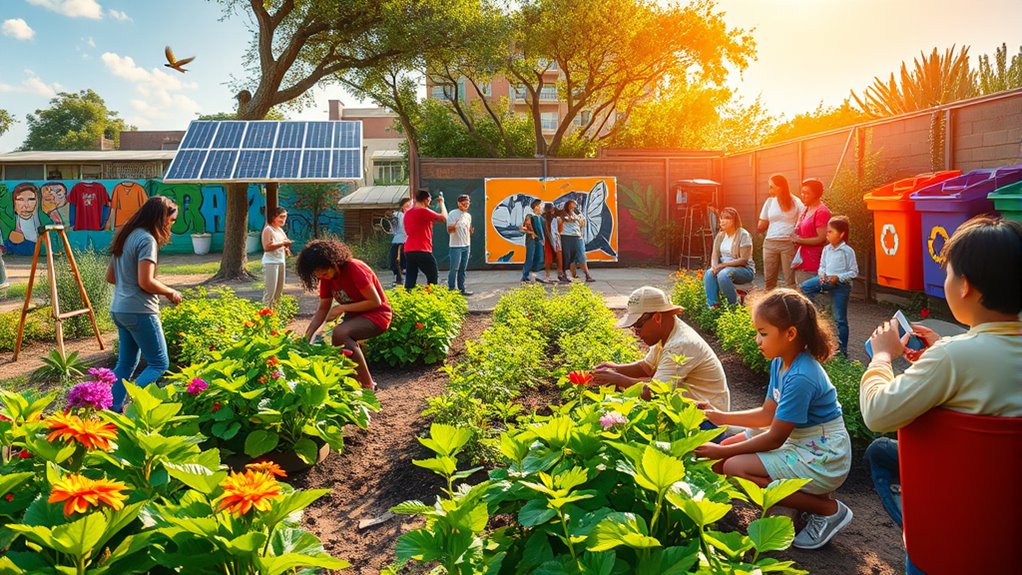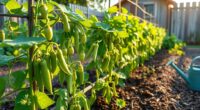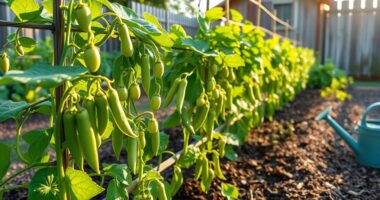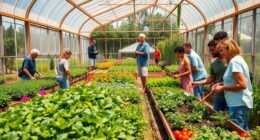I'm thrilled to share that for World Environment Day 2025, a great mix of hands-on projects can make a real difference! You can engage with creative kits like the Earth Day Party Favors Crafts Kit or explore eco-projects in "The Extraordinary Book That Eats Itself." Consider diving into fun activities with "The Environment: Explore, create and investigate!" and "Explore Weather and Climate!" Each project boosts awareness and creativity. Stick around, and I'll share even more exciting eco-friendly ideas!
Key Takeaways
- Create a community garden to promote biodiversity and teach sustainable practices through hands-on experience and collaboration.
- Organize a recycling art project, encouraging participants to transform waste into creative pieces, fostering awareness of reuse and waste reduction.
- Host a nature walk or cleanup event, engaging local communities in environmental stewardship while appreciating local ecosystems and wildlife.
- Implement a school-based eco-challenge, where students complete various sustainability tasks, reinforcing environmental consciousness through competition and teamwork.
- Design educational workshops focusing on eco-friendly living, utilizing resources like "Choose to Reuse" to teach practical conservation methods for families.
24 Set Earth Day Party Favors Crafts Kit
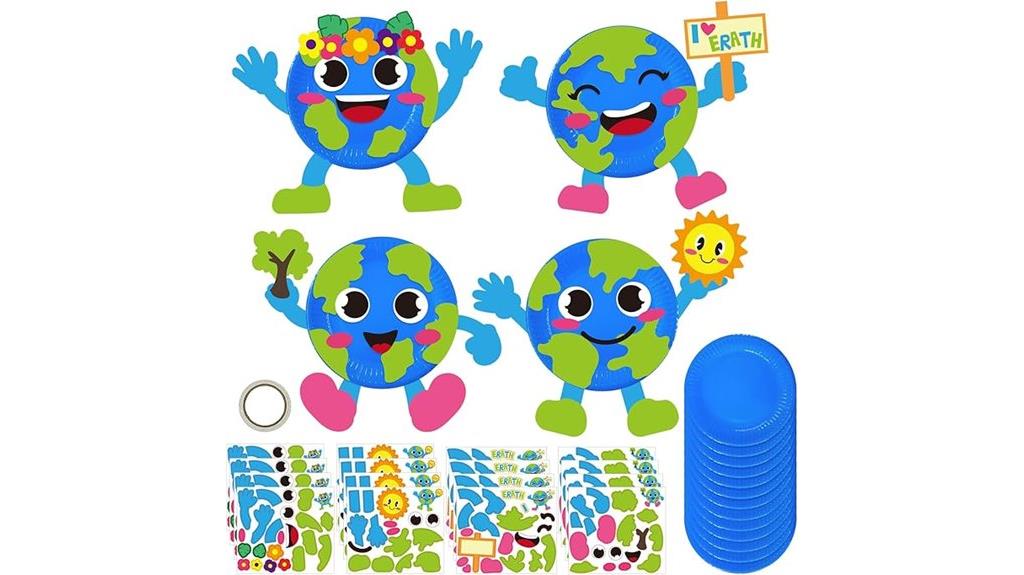
If you're looking for a fun and engaging way to celebrate World Environment Day, the 24 Set Earth Day Party Favors Crafts Kit is perfect for kids. I love how this kit includes 24 adorable plates and card stock sheets with vibrant earth patterns. It's ideal for classroom activities, encouraging creativity while kids assemble decorations. I've noticed it really enhances their fine motor skills and coordination! Plus, the materials are tear-resistant and non-fading, making them durable for various events. Whether it's a birthday party or an educational gathering, this kit brings joy and inspiration to every celebration.
Best For: This product is best for educators and parents looking to engage children in creative and environmentally-themed activities during celebrations like World Environment Day.
Pros:
- Bright and vibrant earth patterns that attract children's attention.
- Durable, non-fading, and tear-resistant materials suitable for various events.
- Encourages creativity and enhances fine motor skills through hands-on assembly.
Cons:
- Limited to a specific theme, which may not be suitable for all party types.
- Contains only 24 sets, which may not be enough for larger groups.
- Availability may be restricted to certain regions due to being imported from China.
The Extraordinary Book That Eats Itself: An Eco Project Book

For families looking to inspire their children's love for nature, *The Extraordinary Book That Eats Itself* stands out as an engaging and educational resource. This 64-page gem offers 30 hands-on eco-projects, perfect for kids aged 5-9. I've seen my grandchildren engage in activities like building a wormery and crafting eco-friendly glue, all while learning about recycling and reducing waste. Parents rave about how it captivates young minds and keeps them entertained. It's a fantastic gift for any occasion, encouraging creativity and a deeper connection to our environment. You'll definitely want this book on your family's shelf!
Best For: Families with children aged 5-9 who want to inspire a love for nature and engage in hands-on eco-friendly projects.
Pros:
- Promotes environmental education through fun and engaging activities.
- Suitable for a wide age range within early childhood, captivating young readers.
- Encourages creativity and hands-on learning, fostering a deeper connection to nature.
Cons:
- Some projects may require additional materials not included in the book.
- Limited complexity for older children, as it's primarily aimed at younger kids.
- The book's focus on eco-projects may not appeal to all children or parents.
The Environment: Explore, create and investigate! (What On Earth?)

As a grade school reader, you'll find "The Environment: Explore, create and investigate! (What On Earth?)" to be an engaging introduction to our planet's wonders. This book teaches you about the environment, like what it means, endangered species, and how greenhouse gases impact our world. You'll love the hands-on projects, such as making microhabitats and mini greenhouses, which let you explore nature up close. The cheerful illustrations make learning easy and fun, while quizzes help you remember what you've learned. It's a must-read for anyone wanting to respect and protect our beautiful Earth!
Best For: Grade school readers eager to learn about the environment and develop a respect for nature.
Pros:
- Engaging hands-on projects promote interactive learning and creativity.
- Cheerfully illustrated to captivate young readers and simplify complex topics.
- Includes quizzes to reinforce knowledge and make learning fun.
Cons:
- May not cover advanced environmental concepts for older students.
- Some projects may require adult supervision or assistance.
- Limited depth on certain topics for readers seeking more detailed information.
Explore Weather and Climate!: With 25 Great Projects (Explore Your World)

"Explore Weather and Climate!: With 25 Great Projects" is perfect for young science enthusiasts keen to plunge into hands-on learning. I found this book incredibly engaging for kids aged 8 and up, providing all the materials needed, like jelly jars and balloons, for exciting experiments. Each project successfully yielded results, although creating a rainbow was a bit tricky without enough sunlight. I appreciated the gentle approach to climate education, avoiding alarmism, and it sparked curiosity in my kids. If your child enjoys exploring scientific concepts, this book is a fantastic resource to inspire their passion for weather and climate!
Best For: This book is best for children aged 8 and up who are eager to learn about weather and climate through hands-on projects.
Pros:
- Provides all necessary materials for experiments, promoting independence in learning.
- Engaging projects successfully demonstrate weather and climate concepts in a fun way.
- Gentle and non-alarmist approach to climate education fosters curiosity without fear.
Cons:
- Some projects, like creating a rainbow, may be challenging due to external conditions like insufficient sunlight.
- Oversimplification of climate zones may not fully represent the diversity of climates in various regions.
- Limited to children aged 8 and up, which may exclude younger budding scientists from participating.
What Will the Weather Be? (Lets-Read-and-Find-Out Science 2)

You might wonder what makes "What Will the Weather Be? (Lets-Read-and-Find-Out Science 2)" such a great choice for young readers fascinated by the weather. This book, aimed at kids aged 3-8, captivates with vibrant illustrations and straightforward explanations. Even if younger kids find some concepts challenging, they'll still benefit from learning new vocabulary. It's perfect for kindergartners, though the length might be a bit much for some. Parents rave about reading it together, and educators appreciate its clarity. Overall, it's a fantastic addition to any home or school library, sparking curiosity about our ever-changing weather.
Best For: Young readers aged 3-8 who are curious about weather and enjoy engaging illustrations and clear explanations.
Pros:
- Engaging and colorful illustrations that captivate children's attention.
- Enhances vocabulary and understanding of weather concepts, beneficial for early learners.
- Positive feedback from parents and educators for its clarity and educational value.
Cons:
- Some advanced concepts may challenge younger readers, particularly 4-year-olds.
- The book's length may be overwhelming for some kindergartners.
- Limited appeal for children who are not interested in weather topics.
Californias Spanish Missions – Social Studies Book for Kids
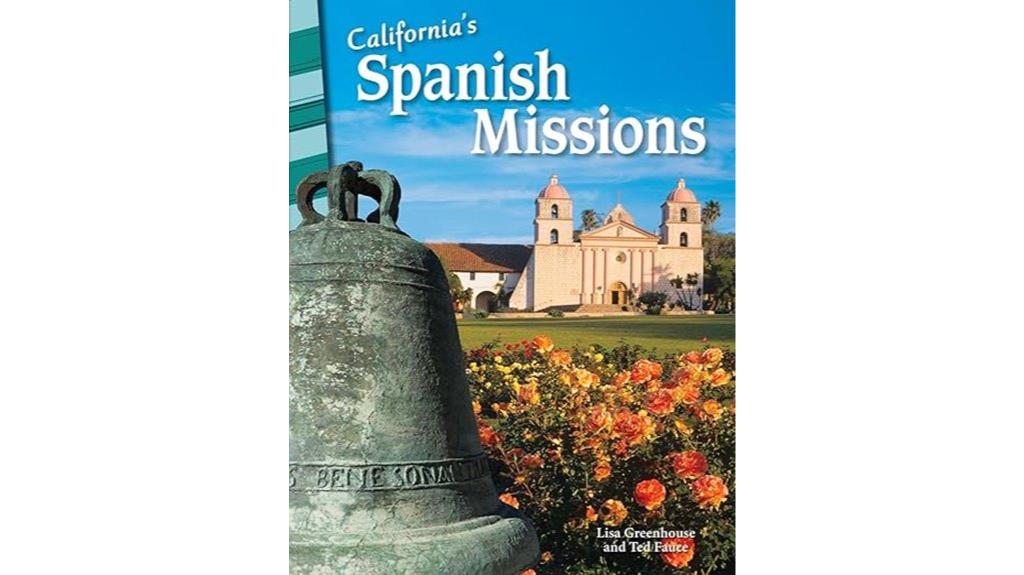
California's Spanish Missions – Social Studies Book for Kids is an excellent resource for younger elementary students keen to learn about the state's rich history. I found it perfect for homeschool settings, especially for kids who love exploring new topics. The clear, concise information offers a solid overview of California's missions, and the vibrant pictures really bring the content to life. It's great for school projects or book reports, encouraging discussions and daily reading. While my daughters loved it, some parents might wish for a deeper dive for older kids. Overall, it's a charming introduction to an important historical subject.
Best For: Younger elementary students and homeschool families looking for an engaging introduction to California's Spanish Missions.
Pros:
- Clear and concise information that provides a solid overview of the subject.
- Vibrant pictures enhance the reading experience and engage young learners.
- Encourages discussions and is suitable for school projects and book reports.
Cons:
- May not provide enough depth for middle school age children.
- Some parents desire a more robust read for older students.
- Limited appeal for readers looking for advanced historical content.
Sustainable Home: Practical Projects for an Eco-Friendly Household (Volume 1)
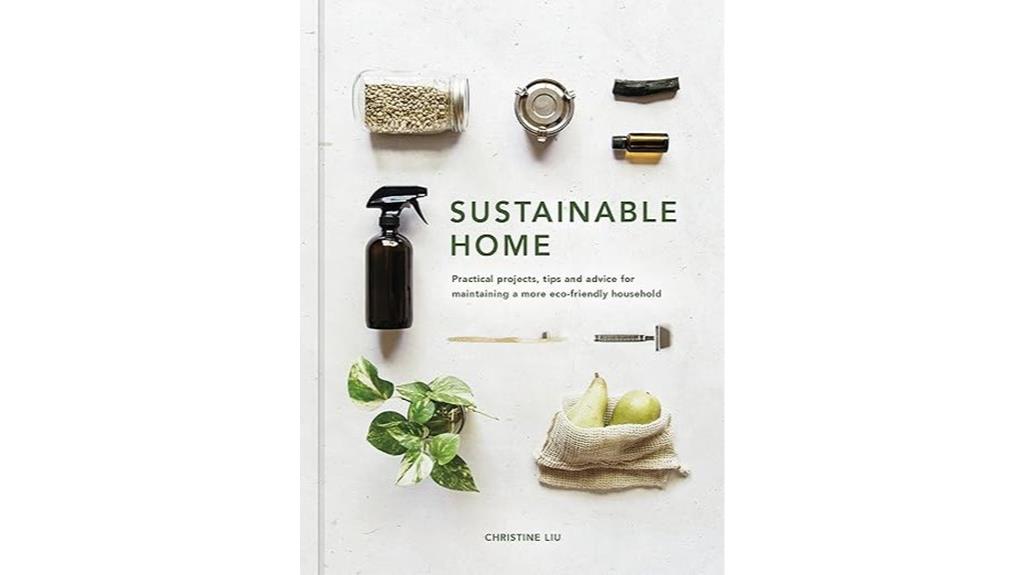
For anyone stepping into the world of eco-friendly living, "Sustainable Home: Practical Projects for an Eco-Friendly Household (Volume 1)" is a fantastic starting point. Christine Liu's guide offers practical tips that make sustainable living accessible. I found actionable suggestions like creating a herb garden and separating garbage particularly helpful. The book covers various rooms and even includes some simple DIY recipes, although I wished for more extensive projects. It's perfect for beginners looking to adopt a minimalist lifestyle. While some advice may seem basic, it inspired me to make gradual changes and embrace a more environmentally friendly home.
Best For: Individuals new to eco-friendly living who are looking for practical tips and inspiration to create a more sustainable household.
Pros:
- Offers actionable suggestions that are easy to implement in daily life.
- Covers various rooms in the house, making it comprehensive for different areas of home life.
- Inspires readers to gradually adopt a minimalist lifestyle and make environmentally conscious choices.
Cons:
- Some advice may feel overly simplistic or common sense to experienced readers.
- Limited DIY projects and recipes may not satisfy those seeking extensive crafting instructions.
- Primarily suited for beginners, which might leave seasoned sustainability advocates wanting more depth.
Choose to Reuse (Cloverleaf Books ™ ― Planet Protectors)
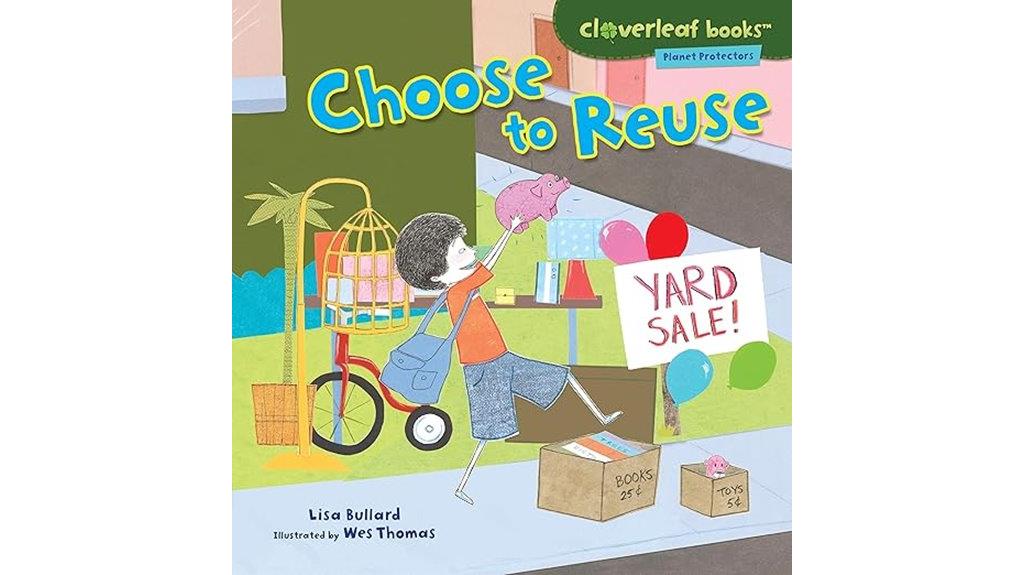
"Choose to Reuse" from Cloverleaf Books™ is an excellent choice for young readers enthusiastic to become planet protectors. This book teaches kids about the importance of reusing items and reducing waste. I love how Tyler sorts school supplies and packs clothes for his cousin, showing practical ways to reuse. It highlights the environmental impact of manufacturing and encourages us to think twice before buying new. With fun activities like making reusable napkins from T-shirts, it's both educational and engaging. Plus, the sidebars offer actionable tips, making it a fantastic resource for anyone looking to make a difference for our planet.
Best For: Young readers who are eager to learn about environmental conservation and the importance of reusing items to reduce waste.
Pros:
- Educational: Provides valuable lessons on recycling and the environmental impact of manufacturing.
- Engaging Activities: Includes fun projects like making reusable napkins, making learning interactive.
- Practical Examples: Offers relatable and actionable tips that children can easily implement in their daily lives.
Cons:
- Limited Audience: Primarily targeted at younger children, which may not appeal to older readers.
- Simplistic Concepts: Some information may be too basic for those already knowledgeable about environmental issues.
- Potentially Regional: Availability of thrift stores and garage sales may vary by location, affecting the book's practical application.
The Wild World Handbook: Habitats
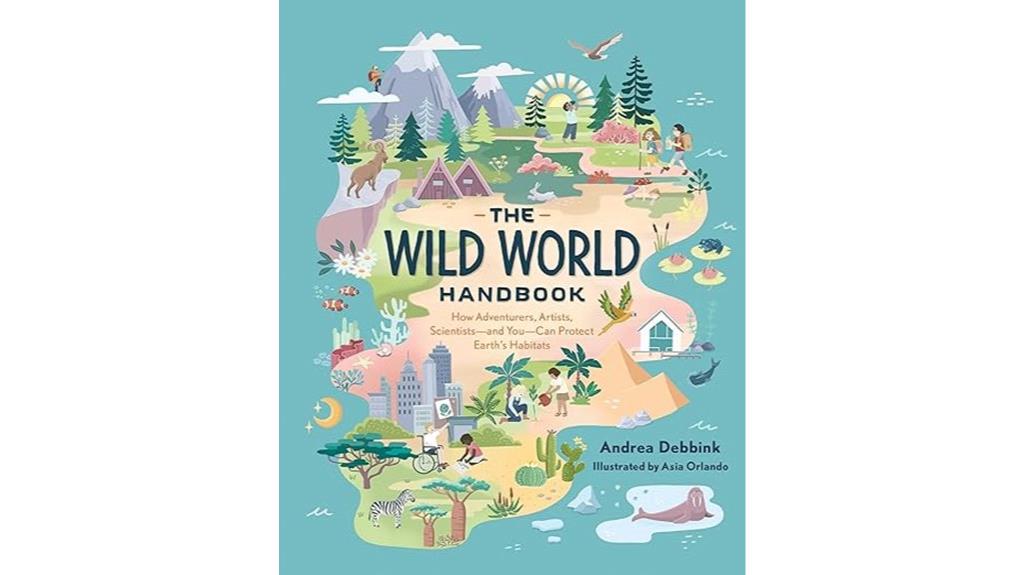
If you're looking for an enchanting way to engage middle-grade readers with the wonders of our planet, "The Wild World Handbook: Habitats" is an excellent choice. This book introduces readers to nine diverse habitats, from forests to oceans, packed with vibrant illustrations and inspiring true stories. Each chapter offers biographies of influential figures, practical DIY projects, and field trip suggestions that spark curiosity. It emphasizes conservation and encourages stewardship, making it a valuable resource for both students and teachers. Overall, this handbook fosters an appreciation for nature while providing actionable ideas to protect our beautiful Earth.
Best For: The Wild World Handbook: Habitats is best for middle-grade readers eager to explore and learn about global habitats while fostering a love for the environment.
Pros:
- Engaging Content: The book features vibrant illustrations and inspiring stories that capture the interest of young readers.
- Hands-on Activities: It includes DIY projects and field trip suggestions that promote interactive learning and environmental stewardship.
- Educational Resource: The handbook serves as a valuable tool for both students and teachers, enhancing understanding of ecological significance and conservation efforts.
Cons:
- Limited Depth: Some readers might find the coverage of topics too brief, lacking in-depth analysis of each habitat.
- Target Age Specificity: The content may not appeal to older readers or those outside the middle-grade age group.
- Potential Overwhelm: The variety of activities and information might overwhelm some young readers, making it challenging to focus on specific topics.
Green$ense for the Home: Rating the Real Payoff from 50 Green Home Projects

Homeowners enthusiastic to enhance their living spaces while making a positive environmental impact will find "Green$ense for the Home" an invaluable resource. This practical guide offers 50 green home projects, organized by expense and difficulty. Each concise chapter provides actionable steps, detailed cost analyses, and environmental benefits. I appreciate how it breaks down projects, making green living accessible to everyone, whether you're a DIY enthusiast or prefer professional help. With its clear instructions and motivational tone, this book empowers us to reduce utility costs, increase home value, and greatly lower our carbon footprints. Let's make a difference together!
Best For: Homeowners looking to undertake green home improvement projects that enhance sustainability and increase property value.
Pros:
- Comprehensive Guide: Offers 50 diverse projects categorized by cost and difficulty, catering to various skill levels.
- Motivational Tone: Encourages readers to take actionable steps towards sustainable living, making the process feel achievable.
- Detailed Analysis: Provides thorough cost assessments and environmental benefits for each project, helping homeowners make informed decisions.
Cons:
- Limited Scope: Focuses primarily on home projects, which may not appeal to those interested in broader environmental issues.
- DIY Emphasis: Some readers may find the DIY projects challenging without professional assistance, potentially limiting accessibility.
- Concise Chapters: While brevity is beneficial, some readers may desire more in-depth information on specific projects and techniques.
Factors to Consider When Choosing World Environment Day Projects
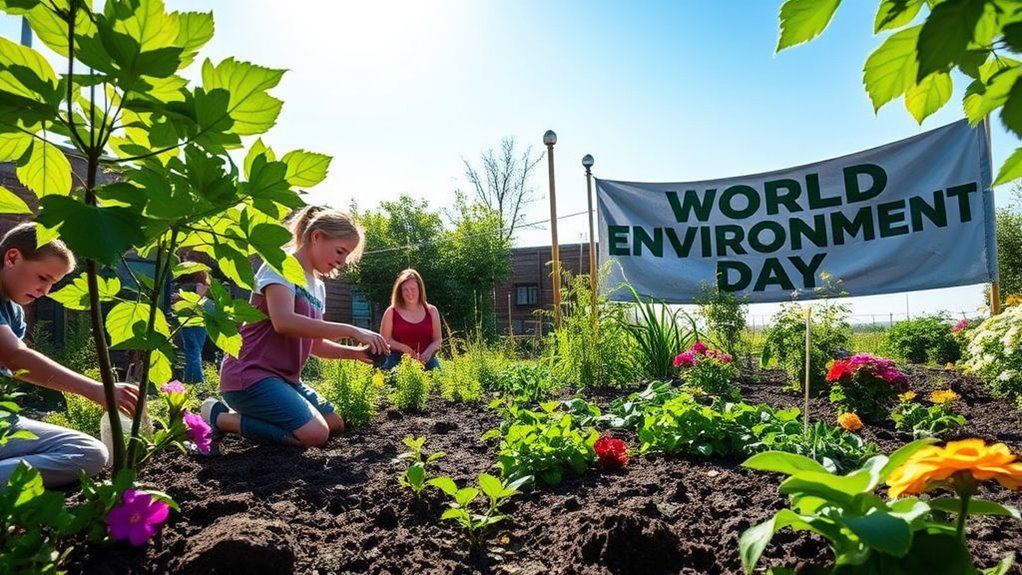
When I choose World Environment Day projects, I consider several key factors that can really make a difference. It's important to think about the project's age appropriateness, its educational value, and the resources I have available. I also look for how hands-on the project is and its potential impact on the environment.
Project Age Appropriateness
Choosing the right World Environment Day project can greatly enhance a child's learning experience, especially when you consider their age group. For younger children, ages 3-8, I find that projects with engaging illustrations and simple concepts really capture their attention and help with vocabulary growth. As kids grow older, especially in elementary school, I can introduce more complex topics that require critical thinking, like creating mini greenhouses or researching endangered species. It's vital to strike a balance between educational value and fun. Incorporating interactive elements, such as quizzes and DIY activities, makes learning enjoyable for all age groups. By selecting age-appropriate projects, I guarantee that kids remain engaged while learning about environmental conservation.
Educational Value Assessment
While selecting World Environment Day projects, it's important to assess their educational value to guarantee they resonate with young learners. I focus on projects that stimulate creativity and critical thinking, especially for kids aged 5-9. Hands-on activities that promote environmental engagement are vital for understanding concepts like recycling and sustainability. I also look for interactive elements, such as quizzes or DIY activities, which make learning enjoyable and accessible. Diverse materials catering to various learning styles assure that projects are both informative and fun. Finally, I consider initiatives that encourage community involvement, as they foster collaboration and a sense of responsibility, enhancing social learning and inspiring collective action for our planet's future.
Resource Availability Consideration
To guarantee a successful World Environment Day project, I always consider the availability of resources right from the start. I assess what materials are needed and ascertain they can be sourced locally and sustainably, reducing transportation's environmental impact. I also evaluate the tools and equipment required, as access to these can greatly affect feasibility. It's essential to match the project's demands with the skills and expertise of participants, so I always keep that in mind. Additionally, I look for potential partnerships with local organizations that can provide extra resources or materials. Finally, I plan for costs associated with sourcing these items, ensuring the project remains financially viable within our budget.
Hands-On Engagement Level
Considering the availability of resources sets a solid foundation for any World Environment Day project, but the hands-on engagement level is what truly brings the experience to life. I love seeing kids immerse themselves in activities like building a wormery or creating mini greenhouses; these projects make environmental concepts tangible and relatable. When they use familiar household materials, it sparks independent learning and exploration. Crafts that involve assembling decorations from eco-project books not only boost creativity but also reinforce environmental themes. Incorporating interactive elements like quizzes or DIY challenges deepens their connection to environmental stewardship. Plus, engaging them in reusing and recycling activities teaches practical sustainability skills they can apply in their everyday lives.
Environmental Impact Potential
When selecting World Environment Day projects, it's vital to focus on their environmental impact potential. I always assess how much a project can reduce carbon footprints, as cutting greenhouse gas emissions plays a significant role in mitigating climate change. Waste reduction is another key factor; I prioritize initiatives that promote recycling or repurposing materials to minimize landfill contributions. Additionally, I evaluate projects based on their ability to preserve biodiversity, especially those protecting endangered species or restoring natural habitats. I also consider the educational value, as projects that raise awareness can inspire community engagement and encourage long-term behavioral changes. Finally, I look for initiatives that foster sustainable practices, like energy efficiency and water conservation, which provide resource savings over time.
Group Participation Opportunities
Group participation in World Environment Day projects offers a unique opportunity to unite individuals with diverse skills towards a shared environmental goal. When I engage in group projects, I notice how collaboration fosters teamwork, allowing us to combine our resources effectively. It's amazing how these activities enhance community bonds and spark social interaction as we share ideas about conservation. We learn from one another, exchanging knowledge on sustainability practices and environmental issues that might be new to some of us. Our collective efforts amplify the impact of our projects, increasing awareness and outreach. Plus, the diverse perspectives we bring lead to innovative solutions for environmental challenges, making our contributions even more meaningful. Together, we can make a difference!
Fun Factor and Creativity
Engaging in projects that spark creativity and fun can elevate our World Environment Day experiences. When we involve children in hands-on activities, like crafting or building, we stimulate their imagination and enhance their problem-solving skills. It makes learning enjoyable and memorable. I love how projects that reuse materials not only promote sustainability but also challenge us to think outside the box. We can innovate designs that address local ecological issues while having a blast. Creating art from recycled materials can motivate families to adopt eco-friendly practices in their daily lives. Ultimately, the fun factor in our environmental projects can lead to unique solutions and lasting connections with nature, making our efforts truly impactful. Let's get creative this World Environment Day!
Frequently Asked Questions
How Can I Get Involved in Local Environmental Initiatives?
Getting involved in local environmental initiatives is easier than it seems! I started by researching local organizations online and attending community meetings. Volunteering for clean-up events or tree planting is a great way to connect with like-minded individuals. I also joined a local environmental group on social media to stay updated on upcoming projects. Don't hesitate to reach out to local leaders; they're often thrilled to have new volunteers join their cause!
What Are Some Effective Ways to Promote Sustainability in Schools?
To promote sustainability in schools, I've found a few effective strategies. First, I get students involved in recycling programs and composting efforts. I also advocate for implementing a green curriculum that teaches environmental responsibility. Organizing eco-clubs helps foster a community focused on sustainability, and I encourage projects like garden spaces where students can learn about growing food. Finally, I collaborate with teachers to integrate sustainability into everyday lessons, making it a school-wide priority.
What Materials Are Best for Eco-Friendly Crafts?
Imagine a garden where every flower blooms from recycled paper and every leaf whispers secrets of reused fabrics. When I craft eco-friendly projects, I love using materials like cardboard, old newspapers, and glass jars. They not only tell stories of their past but also inspire creativity. I've found that natural fibers, such as cotton or jute, work wonders, too. Let's transform our waste into art and watch our planet thrive together!
How Can Families Participate in World Environment Day Activities?
I think families can really make a difference on World Environment Day by getting involved in local clean-up events or tree-planting activities. We could also organize a recycling drive in our neighborhood, encouraging everyone to bring their recyclables. Another idea is to create eco-friendly crafts together, using materials we already have at home. It's a fun way to bond and teach kids about sustainability while making a positive impact on our environment.
What Are the Long-Term Impacts of Environmental Projects on Communities?
Like planting a seed, environmental projects can blossom into long-lasting benefits for communities. I've seen firsthand how these initiatives create cleaner air and promote biodiversity. They foster a sense of unity among residents, encouraging teamwork and shared responsibility. Over time, they can lead to healthier lifestyles, increased property values, and even economic growth through sustainable practices. By investing in our environment today, we guarantee a thriving community for generations to come.
Conclusion
As we gear up for World Environment Day in 2025, remember that even small actions can lead to big changes. Did you know that if every person in the U.S. recycled just one-tenth of their newspapers, we could save about 25 million trees each year? By engaging in projects like those mentioned, we can all contribute to a healthier planet. Let's get inspired and make a difference together—every effort counts!
